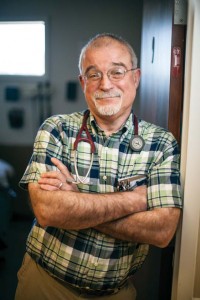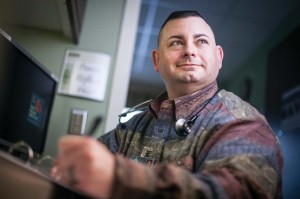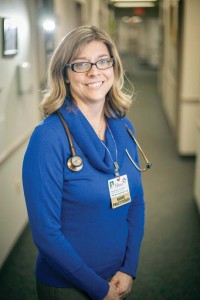
In the dictionary, a preceptor is “an instructor; teacher; tutor.” At Vanderbilt University School of Nursing, a preceptor is one of the most important roles in the evolution of a nursing student.
Preceptors are one-on-one mentors responsible for training students during clinical placements. They help students take what they have learned in the classroom and apply it to real patients in real health care settings.
“To simplify it, it’s an internship. Preceptors can be doctors or nurse practitioners, and they take the student into their practice to train in their area of specialization, from family practice to nurse midwifery,” said LeeAnn Ruderer, director of Clinical Placement at VUSN.
“They’re the lifeblood of our school and an integral part of every program.”
Clinical requirements for students range from 680 hours to 1,000 hours, depending on their specialty. The Clinical Placement Department at VUSN has a staff of five who oversee the placements of all students. They seek out preceptors, arrange placements, negotiate contractual agreements and manage compliance with state boards of nursing and education.
This spring semester, the department has positioned nearly 200 students in Tennessee and 158 students in 39 other states. Sites include hospitals and private practices, work-site-based clinics, rural clinics, federally-qualified health care centers and nonprofits.
“The best learning experiences are out in the community, where you see, hear and experience it all,” said Crickett Harmer, Senior Clinical Placement Program Coordinator.
As VUSN’s distance learning expands, more students are seeking good clinical experiences. But without any connections to the local health care scene, that can be a daunting process. The department makes every effort to customize the student experience by close collaboration with the student, faculty, alumni and potential preceptors.
The VUSN Alumni Board has made it a goal to increase their role to find more preceptors around the country.
“With the increasing number of students who are doing their rotations outside of Tennessee, it was the desire of the Alumni Board to help find qualified supervising advanced practice nurses. Therefore the committee is going to work this next year to help expand the number of preceptors as well as the scope of specialties,” said board president Doug Arrington.
Ruderer said finding a preceptor is often time-consuming and stressful for distance students.
“It can be very hard to find a preceptor in their area who is also in their specialty. It would be wonderful to connect more with our alumni for leads on possible placements. Even if they’re not, say, a nurse midwife, they may know an OB-GYN practice in town that would be an excellent training opportunity for a women’s health student or a family practice for another specialty. Tips like that are so helpful.”
Even locally, the competition for clinical placements is stiff.
“We often contact some sites and they are already booked for a year or two. Our local preceptors will tell us they are bombarded with calls from students at other schools. We see this as wonderful that the nursing field is growing, but challenging for securing the best training experiences,” Harmer said.
The biggest need is for primary care preceptors because so many specialties require that experience. Other high priorities are pediatrics and OB-GYN.
Arrington said he can still remember the impact of his clinical rotations and hopes other alumni will volunteer as preceptors.
“Working with students is a great experience. I always learn way more than I feel that I provide for the student. By serving as a role model for students it allows them to see the true capacities that advanced practice nurses can fulfill,” he said.
Harmer echoed that two things—the opportunity to learn the latest practices and theories from students and a “pay it forward” mentality—drive preceptors to volunteer.
“Many of our preceptors say how important their clinical experiences were and how they want to give back.”
Preceptors can receive continuing education credits for teaching students.
“Our preceptors say they love to have students because it helps them learn as well,” Ruderer said. “They find joy in teaching because they can be a mentor to the student and help foster and nurture their love of health care.”
Here are the stories of just three of the hundreds of preceptors who go beyond the definition.
* * * * * *

David McClain has precepted more than 30 VUSN students over the past 15 years at the Bell Clinic in rural Elkton, Ky. Twenty miles from the nearest hospital, the clinic sees 25-50 patients a day with complaints that run the health care gamut.
McClain actually did a rotation at the clinic while he was in school and joined the staff after his 1995 graduation from the Family Nurse Practitioner program.
“About a year after I started working, I got a call asking me to be a preceptor. I was willing to because everyone has to learn somewhere. Somebody was kind enough to help me when they didn’t have to, and I wanted to pass that on,” he said.
McClain is particularly adept at helping nurses with hospital experience transition to caring for patients in a clinic on their own.
“Hospital nurses have a certain set of eyes that don’t fit out here. In the hospital, you already know the patient has complex needs. In the clinic, we keep them healthy. Nurses are often good at the sick, but it’s how to keep patients from being sick or from getting sicker that has to be learned.”
Teaching comes naturally for McClain, who has many educators in his family. He also taught a course at Walter Reed National Military Medical Center while he was a critical care nurse in the Army.
He often starts teaching by having the students do a head-to-toe assessment.
“I tell them to look at everything because they don’t know enough to filter the meaningful from the red herrings. From all that data, the problem usually falls out. Eventually, they will get the skills to start filtering the meaningful information. I want them to be able to do a history and physical in their sleep.”
McClain said he is usually standing over the student’s shoulder, but takes a more encouraging approach.
“They’re under a lot of pressure already, so I try not to teach in a berating way. If they knew everything they were supposed to, they would already be a nurse practitioner. I tell them to take it easy and enjoy the opportunity to learn.”
He often picks the students’ brains about what they are learning in class, and has them look up more information on conditions they encounter in the clinic.
“If they walk out at the end of the day feeling inadequate but enlightened, we’re doing it right.”

James Hope sees preceptors as a type of quality control for Vanderbilt’s new graduates.
“Everyone with that (VUSN) pin on their collar is a representative of Vanderbilt. They should come out of school being strong and at the top of the market.
We want to teach them well so we’re all seen as good nurse practitioners. We want to keep the value of that degree high,” he said.
A 2009 graduate of the Acute Care Nurse Practitioner Program, Hope works as a hospitalist for Johnson City Internal Medicine, managing the night admissions and emergencies for the private physician group’s patients at Johnson City Medical Center in eastern Tennessee.
Student and preceptor usually see a patient together, and then Hope asks the student to present the patient, indicating the significant findings and major problems.
“The important thing is finding the most pressing issue. To put it bluntly, what is going to kill them first? Then we sit together and write the orders.”
He often has to stress that health is a continuum and the goal is to bring the patient back to baseline to go home.
“Some people have chronic problems and will never be totally healthy. Students need to understand what that patient’s baseline level of health is so that we can set goals to get the patient out of the hospital.”
Hope also tries to drive home the unique aspects of nurse practitioners.
“I emphasize that we’re still a nurse and have a different philosophy of health care than physicians. I tell them that one of the great things is that many people prefer to see us. We’re not just a diagnosis—we do mind, body and spirit.”
One of his tricks of the trade he encourages students to copy, is carrying a list of $4 prescriptions at Wal-Mart.
“If a patient has $20 in their pocket and you prescribe a $50 medication, you haven’t done them any good,” he said.
Hope said he also benefits from precepting because he can learn about the latest research and new practices.
“As students, they’re always learning the newest info, which is a big bonus when they come in. It’s also nice just to review stuff you already know.”
He precepted a VUSN student in 2012, who was also a staff nurse at Franklin Woods Community Hospital, where Hope covers call.
“She came from a heart failure clinic and could rattle off tons of information about that. She was very smart but didn’t have a lot of self-confidence, so we worked on building that.”
“But every student is different. I try to figure out their strengths and weaknesses and what they want to garner from the experience.”

For Stephanie Franklin, the rewards of being a preceptor far outweigh the time constraints and extra planning required when a student is under her guidance.
“It can be challenging to give students the time they need and also move forward with the hectic schedule of the clinic, but it is very rewarding. It keeps me on my toes. It’s been a long time since I was in school, and they come in with new and fresh ways of doing things. It forces me to keep learning,” she said.
Franklin is a 1993 graduate of VUSN and works at Eldorado Primary Care, a family practice clinic in Southern Illinois owned by Harrisburg Medical Center. She is one of three nurse practitioners on a staff with two physicians and three counselors, and actually precepted the other two nurse practitioners when they were students.
The clinic often has students on rotations, and Franklin said the key to giving them a good experience while maintaining patient flow is scheduling.
“For the students, I choose patients who have a little extra time, who don’t have to rush back to work, and I try to schedule their follow-up when the student will be here. That way they can see how the labs come back and follow the progression of the patient. They really enjoy that continuity, and it’s more like real practice,” she said.
Franklin said patients rarely mind having a student involved in their care.
“The patients usually enjoy the students. They feel like they get such thorough exams and really good patient education. The patients will always ask where the students are and how they’re doing.”
In 2011, Franklin precepted VUSN student Natalie Finnie, now a nurse practitioner at Gallatin County Wellness Center, a primary care clinic associated with the local schools in Junction, Ill. Finnie had called on Eldorado Primary Care when she was a drug rep, and Franklin was her first choice for a preceptor.
“I thought she was a great practitioner and really respected her,” Finnie said. “I was thankful I was able to hand pick her.”
Finnie said Franklin was great at assessing her knowledge base and giving her just the right amount of direction.
“She was hands-on at first and had me watch her, then let me do things on my own. I wanted feedback immediately and would ask what I needed to sharpen my skills, and she was very good at giving guidance. She has a crazy busy schedule but never made me feel like I was in her way.”
For Franklin, the ultimate motivation to be a preceptor is giving back to other nurses.
“Someone did it for us, and it’s our turn to help future students,” she said. “Nurse practitioner is a very exciting field, but it is up to us to advance the field, and part of that is being a preceptor.”